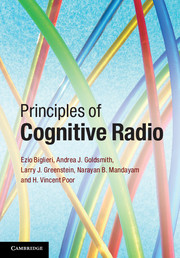3 - Propagation issues for cognitive radio
Published online by Cambridge University Press: 05 December 2012
Summary
Introduction
The fundamental principal of cognitive radio (CR) is to detect other radios in the environment that are using the same spectral resources, and to then deploy transmission and reception strategies that permit secondary users to communicate, while minimizing interference to and from those radios. For the design, analysis, and implementation of such transmission and reception strategies, it is essential to understand the relevant propagation channels [80]. The power emitted by a transmitter (TX) might be determined by the system designer, but it is the channel that dictates how much of it arrives as useful power at the intended receiver (RX), and also how much interference it creates at unintended receivers. Similarly, the signal sensing process of the CR system might be determined by the system designer, but it is the channel that dictates the intervals in time, frequency, and space at which samples should be taken. For example, the temporal variation rate of the channel response dictates how often samples are needed and, thus, how often transmit or receive strategies might have to be adapted. As we will see, many other properties of the channel influence CR design and analysis as well.
Propagation in the cognitive radio bands
CRs may be deployed over a wide range of the frequency spectrum. The bands below about 3.5 GHz have relatively low propagation loss and are sought after by all services. These bands are therefore ideal candidates for the deployment of CR.
- Type
- Chapter
- Information
- Principles of Cognitive Radio , pp. 102 - 149Publisher: Cambridge University PressPrint publication year: 2012
- 2
- Cited by



